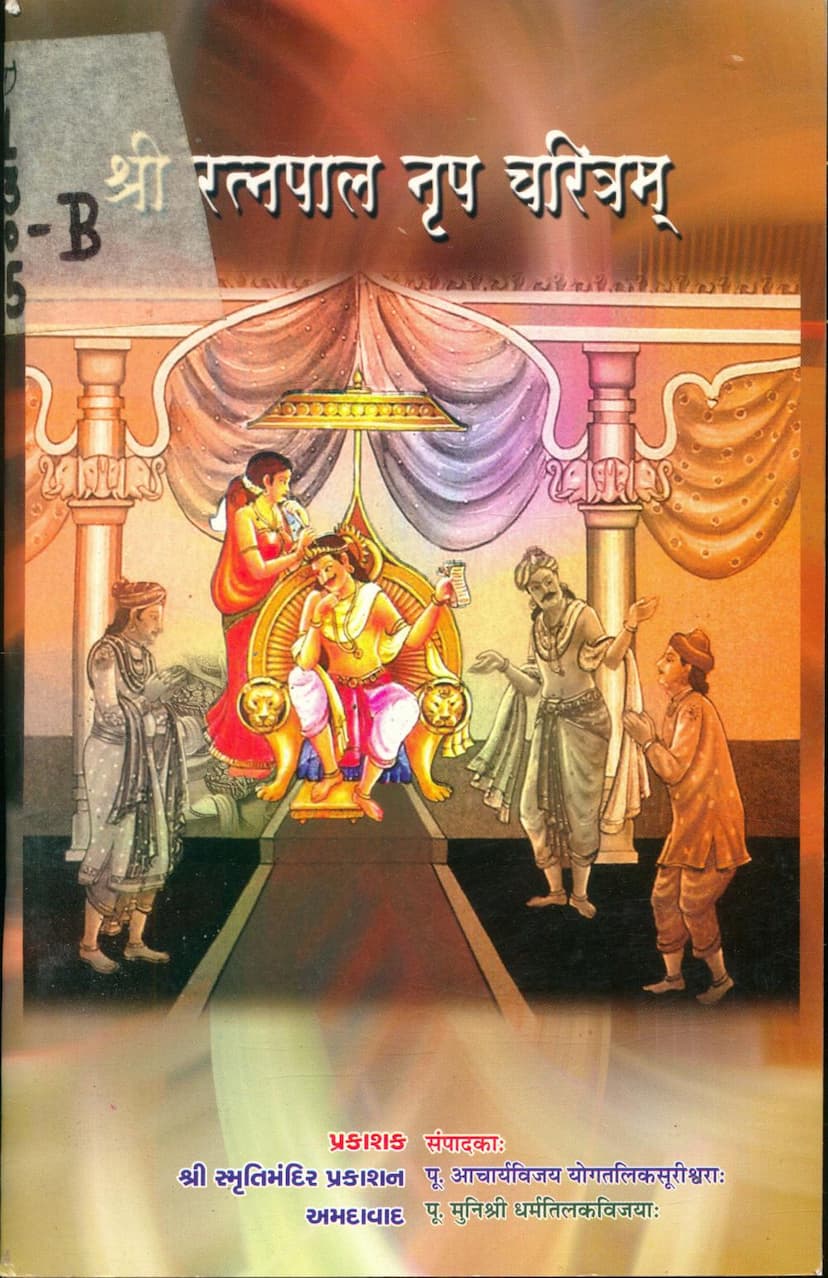Ratnapal Nrup Charitram
Added to library: September 2, 2025

Summary
Here's a comprehensive summary of the Jain text "Ratnapal Nrup Charitram," based on the provided pages:
Title: Shri Ratnapal Nrup Charitram (The Chronicle of King Ratnapal)
Author: Vachanaacharya Shri Sommandal Gani
Publisher: Shri Smritimandir Prakashan, Karnavati
Context and Purpose: This text is a Jain religious narrative, likely composed in Sanskrit (as indicated by the verses and discussions of grammar and meter). It focuses on the "Mahaatmyam of Dana" (The Greatness of Giving), particularly emphasizing the merit of giving to deserving recipients. The publication is dedicated to celebrating the 50th anniversary of the monastic life of Acharya Devesh Shrimad Vijay Narachandrasurishwarji Maharaja, with the editors being Acharya Vijay Yogtilaksurishwarji and Muni Shri Dharmatilakvijayaji. The book aims to make profound Jain principles accessible through storytelling.
Author's Background: The author, Vachanaacharya Shri Sommandal Gani, was a disciple of the esteemed Acharya Shri Munisundarsurishwarji. The text mentions that Shri Sommandal Gani also composed other works, including "Yugadi" (approximately 2500 verses) and "Uttamanarendrathane" (812 verses, unpublished).
Core Theme and Argument: The central argument of the text, as presented in the introductory sections, is the supremacy of Dana (giving) over other forms of religious practice like Shila (virtuous conduct), Tapa (austerities), and Bhava (mental disposition/devotion). The narrative frames a debate among these four pillars of Dharma, where Dana is argued to be the most impactful because it benefits both the giver and the receiver, facilitating their spiritual progress. The text highlights that even a small act of giving to a worthy soul can lead to immense spiritual benefits.
Narrative Content (as suggested by the table of contents and introductory verses):
- Introduction to Dharma: The text begins by defining the fourfold nature of Dharma: Dana, Shila, Tapa, and Bhava.
- The Debate on Dharma: It presents a philosophical debate where each of these aspects claims superiority, emphasizing their unique contributions to liberation. Dana asserts its primary role, highlighting examples like ShAlibhadra, whose single act of giving led to liberation.
- The Story of King Ratnapal: The main narrative focuses on King Ratnapal, detailing his life from birth to his ultimate spiritual attainment.
- His Virtues: Ratnapal is portrayed as a virtuous and valiant king, ruling with justice and prosperity.
- The Swayamvara: A significant event is the Swayamvara (self-choice marriage) of Princess Shringarasundari. King Ratnapal participates and is chosen by her, despite the initial objections and subsequent conflict with other kings.
- The Test of Shringarasundari: The princess's unwavering adherence to Shila (chastity) is tested during a severe ordeal, showcasing her strength and devotion.
- The King's Reign and Challenges: The text describes Ratnapal's reign, his administration, and the challenges he faces, including betrayals by his minister Jaya.
- Acts of Charity and Merit: The narrative is interspersed with examples of Ratnapal's charitable deeds and the spiritual merit they generated.
- Previous Births and Karma: The concept of Karma and rebirth is woven into the narrative, explaining the causes and effects of actions across lifetimes. The story of characters like Siddhadatta and Dhanadatta illustrates the consequences of greed versus wisdom and ethical conduct.
- Renunciation and Liberation: The story culminates in Ratnapal's renunciation of worldly possessions and his attainment of liberation (moksha) after practicing intense austerities and deep meditation.
- Illustrative Tales: The narrative includes various sub-stories and parables to illustrate the principles being discussed. Examples include:
- The story of Dhanashri and the king Vidya-bhrit, showcasing the power of a virtuous woman.
- The tale of the gambler and the goddess Chandi, illustrating consequences.
- The story of the two daughters of Gandharva king Vishwavasu, and how Ratnapal, through his merit and spiritual power, rescues them.
- The story of Kanakamnjari and Guna Manjari, who suffer from leprosy and blindness due to past karma, and are eventually cured by Ratnapal.
- The story of Mugdhabhatta and his wife Sulakshana, highlighting the importance of faith and correct understanding of Jain principles.
- The story of Shringadatta and his extreme greed, serving as a cautionary tale.
- The story of the merchant Siddhadatta and his encounter with a magical plant, illustrating the consequences of greed and the importance of destiny.
- The story of Dhanadatta, who acts wisely and ethically, contrasting with Siddhadatta.
- Moral and Spiritual Lessons: The text imparts lessons on the importance of:
- Giving to the deserving (Satpatra Dana).
- The power of virtue and chastity (Shila).
- The efficacy of austerities (Tapa) and spiritual contemplation (Bhava).
- The karmic consequences of actions.
- The ultimate goal of liberation (Moksha).
Structure and Language: The "Ratnapal Nrup Charitram" is presented in verses (padyam) and is divided into four sections (Parichhedas). The language is described as relatively simple Sanskrit, making it accessible to beginners in Sanskrit studies. The editors have also added new commentary, indicated by English numerals, while retaining the original commentary marked by Sanskrit numerals.
Overall Significance: This work is a valuable contribution to Jain literature, offering a blend of philosophical discussion and engaging narrative. It aims to inspire readers to understand and practice the core tenets of Jainism, particularly the profound significance of charitable giving and ethical conduct, as exemplified in the life of King Ratnapal. The republication of this text by Smritimandir Prakashan makes it available to a new generation of readers seeking spiritual guidance.